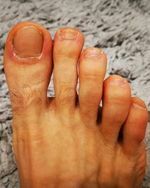Description of hammer toe (also called hammer toe)
A hammertoe is a contracture of the toe as a result of a muscle imbalance between the tendons on the top and the tendons on the bottom of the toe. Hammertoes can be flexible or rigid in nature. When they are rigid, it is not possible to straighten the toe out by manipulating it. Frequently, they develop corns on the top of the toe as a result of rubbing the shoe. They may also cause a painful callus on the ball of the foot. This occurs as a result of the toe pressing downward on the bone behind the toe. This area then becomes prominent and the pressure of the bone against the ground causes a callus to form. They tend to slowly get worse with time and frequently flexible deformities become rigid. Treatment can be preventative, symptomatic or curative.
Différents types de traitements de l’orteil en marteau
Preventive treatment of a hammer toe

Preventive treatment for hammertoe targets the cause of the deformity.
Preventative treatment of a hammertoe is directed toward the cause of the deformity. A functional orthotic is a special insert that can be prescribed by your podiatrist to address the abnormal functioning of the foot that causes the hammertoe. Functional orthotics can be thought of as contact lenses for your feet. They correct a number of foot problems that are caused by an abnormally functioning foot. Our feet, much like our eyes, change with time. Functional orthotics slow down or halt this gradual change in the foot. Often when orthotics are used for flexible hammertoes, the toes will straighten out and correct themselves over time. Calf stretching exercises are also helpful. Calf stretching can help to overcome part of the muscle imbalance that causes the hammertoe.
Symptomatic treatment of a hammer toe
Symptomatic treatment of hammertoes consists of such things as open toed shoes or hammer toe pads. There are over the counter corn removers and medicated corn pads to temporarily reduce the painful callus often seen with a hammertoe. These medications must be used with caution. They are a mild acid that burns off the callus. These medications should never be used for corns between the toes. Persons with diabetes or poor circulation should never use these products.
Curative treatment of a hammer toe
Curative treatment of hammertoes varies depending upon the severity of the deformity. When the hammertoe is flexible, a simple tendon release in the toe works well. The recovery is rapid often requiring nothing more than a single stitch. Of course if several toes are done at the same time.
The recovery may take a bit longer. For the surgical correction of a rigid hammertoe, the surgical procedure consists of removing the damaged skin where the corn is located. Then a small section of bone is removed at the level of the rigid joint. The sutures remain in place for approximately ten days. During this period of time it is important to keep the area dry. Most surgeons prefer to leave the bandage in place until the patient’s follow-up visit, so there is no need for the patient to change the bandages at home. The patient is returned to a stiff-soled walking shoe in about two weeks. It is important to try and stay off the foot as much as possible during this time. Excessive swelling of the toe is the most common patient complaint. In severe cases of hammertoe deformity a pin may be required to hold the toe in place and/or the surgeon may elect to fuse the bones in the toe. This requires several weeks of recovery.
Complications associated with the surgery include infection, excessive swelling, and if excessive bone is removed during the surgery the toe may be a bit floppy. The toe always has a floppy feeling for several weeks following the surgery. This is normal and generally not permanent. If pinning the toe is not required during the procedure, then the surgery could be performed in the doctor’s office under local anesthesia. Many patients prefer the comfort of sedation during surgery, in an outpatient surgery center.
The information provided in this web site is not intended to be a substitute for medical examination, diagnosis or treatment. The material is provided for information purposes alone.

